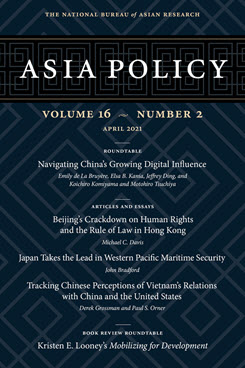The Network Great-Power Strategy
A Blueprint for China’s Digital Ambitions
This essay seeks to explain China’s network great-power (wangluo qiangguo) strategy, including its aims and means, the environment to which it applies, its metrics for success, and the digital ambitions that it propels.
EXECUTIVE SUMMARY
MAIN ARGUMENT
China sees the information technology (IT) revolution as an opportunity to claim leadership over the world order. The network great-power strategy is Beijing’s blueprint for the country to leapfrog the U.S. The strategy drives China’s competitive, global ambition to define the digital era architecture, just as the U.S. claimed similar definitional influence over the post–World War II system. Today’s IT-enabled environment, however, comes with higher stakes.
POLICY IMPLICATIONS
- The network great-power strategy and its ramifications extend well beyond the cyber realm. The emerging digital architecture is poised to shape the real as well as the virtual domains. China’s network great-power strategy relies on efforts in, and seeks influence over, both.
- Beijing assesses that the network power contest hinges on scale, the ability to apply technology, and relative autonomy. Frameworks for understanding China’s competitive capabilities should take this into account.
- Beijing pursues the network great-power strategy through asymmetric integration whereby China establishes a critical role for itself in the international division of labor while keeping its own system relatively protected. Such asymmetry has defined decades of Chinese industrial and technological policy. But whereas in the past China leveraged this approach primarily to acquire access to resources and influence over markets, its asymmetric positioning now gives the country outsized influence over the international architecture.
- The U.S. and China are candidates for systemic leadership at an inflection point that will shape the world. Today’s determinative IT contest is not about developing the best, newest, or shiniest digital technologies but about defining the international architecture.
Emily de La Bruyère is a Co-founder of Horizon Advisory (United States), a consulting firm focusing on the implications of China’s competitive approach to geopolitics, as well as a Senior Fellow at the Foundation for Defense of Democracies. She has pioneered data tools tailored to Beijing’s strategic and institutional structures. Her work focuses on China’s standardization ambitions, military-civil fusion strategy, and platform geopolitics, as well as their implications for global security and the economic order.
About Asia Policy
Asia Policy is a peer-reviewed scholarly journal presenting policy-relevant academic research on the Asia-Pacific that draws clear and concise conclusions useful to today’s policymakers. Asia Policy is published quarterly in January, April, July, and October and accepts submissions on a rolling basis. Learn more


